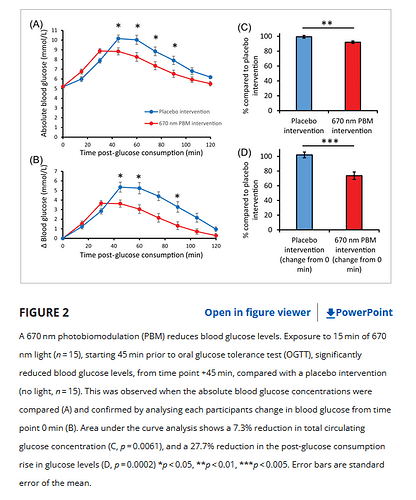Interesting study. I’d love to get a red-light device, if they were cheaper:
Exposure to 15 minutes of red light reduced blood sugar response
They’re not too expensive, just gotta buy them direct.
These people make a majority of the lights for the name brand people. Since import logs are public info, there was a post a couple years ago on Reddit and you could lookup who Jooov, Platinum, Gembared etc where getting their lights.
Which I knew that before I bought my $700 Platinum. The one I use the most now is a $150 HKE and it’s built just as well as the Platinum. Plus of lights with NIR is they can’t fake out and send underpowered lights, since they literally heat you up.
Interesting. Never heard of this before.
I image that if I spent 15 minutes in front of a red light, others would starting honking. 
I remember hearing about these on multiple podcasts, but it was a while ago. I looked into the price and gave up. The small ones are expensive, and the large ones are insane. The Joovv Solo, which is not really that big (about half a body), is $1,600. The cheapest and smallest is $600.
Unfortunately, I don’t know how much you actually need (in terms of area) to get these benefits. Would the smallest work? I’m not sure.
Interesting to know this, the light is quite cheap here, I will buy one for my mom.
Are these the kind of thing you lie in or on and apply red light to your entire body, or just something for your face? Or eyes or whatever?
I wouldn’t think it would be particularly expensive unless it’s hundreds or thousands of LEDs. Power supplies to run LEDs are pretty easy.
My limited understanding is that they’re for the body. They are quite expensive, though.
The Shenzhen ones are cheaper (see the link above by @lfod14), although they aren’t “cheap” there either
I had looked at the link @lfod14 had posted, and saw the LED blanket (?) you lie on and smaller ones. Joovv is showing off handheld ones and a bigger one that the models were standing next to. There’s an illustration in the paper at Wiley that seems to show a small, flashlight-like light, so not the bigger, total body kind.
In the 670 nm PBM group, immediately following initial blood glucose measurement, participants exposed an 800 cm2 region of upper back to 670 nm light for 15 min at an intensity of 40 mW cm−2 (28,800 J). This would illuminate skin cells and underlying musculature including the trapezius [23]. Light was delivered via light emitting diodes (LED); 670 nm peak wavelength with a half power band of ~10 nm (Light Power Health, UK). The LED array was positioned 400 mm from the participants back, surrounded by a shield that rested on the participant’s skin, to prevent light leakage, and to blind the participant to which group they were randomised into. The placebo group underwent the same procedure, except the LED array was not switched on during their placebo intervention.
This just doesn’t sound all that hard. The part that would take the most effort is the packaging. Mounting everything would be the hardest part.

